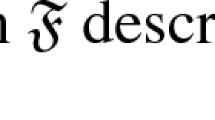Abstract
We prove that if the physical entity S consisting of two separated physical entities S1 and S2 satisfies the axioms of orthodox quantum mechanics, then at least one of the two subentities is a classical physical entity. This theorem implies that separated quantum entities cannot be described by quantum mechanics. We formulate this theorem in an approach where physical entities are described by the set of their states, and the set of their relevant experiments. We also show that the collection of eigenstate sets forms a closure structure on the set of states, which we call the eigen-closure structure. We derive another closure structure on the set of states by means of the orthogonality relation, and call it the ortho-closure structure, and show that the main axioms of quantum mechanics can be introduced in a very general way by means of these two closure structures. We prove that for a general physical entity, and hence also for a quantum entity, the probabilities can always be explained as being due to a lack of knowledge about the interaction between the experimental apparatus and the entity.
Similar content being viewed by others
References
D. Aerts, “Description of many separated physical entities without the paradoxes encountered in quantum mechanics,”Found. Phys. 12, 1131 (1982).
G. Cattanco and G. Nistico, “A note on Aerts' description of separated entities,”Found. Phys. 20, 119 (1990).
C. Piron,Foundations of Quantum Physics (Benjamin, New York, 1976).
C. Piron, “Recent developments in quantum mechanics,”Helv. Phys. Acta 62, 82 (1989).
C. Piron,Mécanique quantique, bases et applications (Presses Polytechnique et Universitaire Romandes, 1990).
D. Aerts, “Classical theories and nonclassical theories as special case of a more general theory,”J. Math. Phys. 24, 2441 (1983).
C. Piron, “Axiomatique Quantique,”Helv. Phys. Acta 37, 439 (1964).
G. Birkhoff,Lattice Theory, 3rd edn. (Am. Math. Soc., Colloq. Publ., Vol. XXV, Providence, Rhode Island, 1967).
D. Aerts and T. Durt, “Quantum, classical and intermediate, an illustrative example,”Found. Phys. 24, 1347 (1994).
D. Aerts, “How do we have to change quantum mechanics in order to describe separated systems,” inThe Wave-Particle Dualism, S. Dineret al., eds. (Reidel, Dordrecht, 1984).
D. Aerts, “The physical origin of the Einstein-Podolsky-Rosen paradox,” inOpen Questions in Quantum Physics, G. Tarozzi and A. van der Merwe, eds. (Reidel, Dordrecht, 1985).
D. Aerts, “The physical origin of the EPR paradox and how to violate Bell inequalities by macroscopic systems,” inFoundations of Modern Physics, P. Lahti and P. Mittelstaedt, eds. (World Scientific, Singapore, 1985).
D. Aerts, “The description of separated systems and quantum mechanics and a possible explanation for the probabilities of quantum mechanics,” inMicro-physical Reality and Quantum Formalism, A. van der Merweet al., eds. (Kluwer Academic, Dordrecht, 1988).
D. Aerts, “A possible explanation for the probabilities of quantum mechanics,”J. Math. Phys. 27, 202 (1986).
D. Aerts, “The origin of the non-classical character of the quantum probability model,” inInformation, Complexity, and Control in Quantum Physics, A. Blanquiereet al., eds. (Springer, Berlin, 1987).
D. Aerts, “A macroscopical classical laboratory situation with only macroscopic classical entities giving rise to a quantum mechanical probability model,” inQuantum Probability and Related Topics, Vol. VI, L. Accardi, ed. (World Scientific, Singapore, 1991).
D. Aerts, T. Durt, and B. Van Bogaert, “Quantum probability, the classical limit and non-locality,” inSymposium on the Foundations of Modern Physics, T. Hyvonen, ed. (World Scientific, Singapore, 1993).
Author information
Authors and Affiliations
Rights and permissions
About this article
Cite this article
Aerts, D. Quantum structures, separated physical entities and probability. Found Phys 24, 1227–1259 (1994). https://doi.org/10.1007/BF02148566
Received:
Issue Date:
DOI: https://doi.org/10.1007/BF02148566




